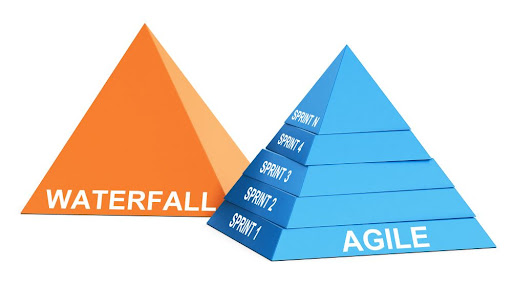What is the waterfall model and when should it be used?

What is a waterfall model?
The waterfall model is one of the first and most widely used project management methodologies. It used to be widely used in software development, but because it is less applicable in a volatile environment, agile methodologies are now used instead. However, it is still used today in many industries, such as construction. But what exactly does the waterfall model mean, what are its advantages and disadvantages, and in general: for which projects should this methodology be used? In this article, we've explored the topic.
For which projects should the waterfall model be used?
- Where project requirements are pre-defined, the industry is not characterised by rapid change
- If the project outcome can be created with existing technology, so no extra R&D is needed
- If you do not need continuous client-side feedback on the results achieved
- If the task is well planned and the expectations are clear and unambiguous
Such projects could be, for example, construction projects or investment projects for large companies.
Phases of the waterfall model
The waterfall model uses a sequential way of thinking, which, as the name suggests, resembles a waterfall. As mentioned above, each stage is typically sequential. Each stage may vary from industry to industry, or may be defined by the technical content of the tasks to be performed, or by management and work organisation aspects. For example, what are typical phases?
#1 Setting requirements and objectives
This is the stage where the project's purpose, key requirements, guidelines and deadlines are broadly defined. There are no concrete implementation plans or process.
Once this has been done, a feasibility study is carried out, a risk analysis is carried out and it is also checked whether the project will actually pay off. From all this, a so-called business case (business plan) is prepared, and once approved, the project can really start.
#2 Designing the project
Careful project planning is essential for successful implementation. A common problem is that insufficient time and resources are devoted to the planning phase, leading to cost overruns, delayed deadlines or even non-compliance with requirements. In such cases, unfortunately, the project cannot be considered a success.
Projektterv
The most important document of the planning phase is the so-called project plan document, the most important elements of which may vary from one organisation or industry to another:
- Roadmap for action
- WBS structure definition - this refers to the structure of the work breakdown
- Assignment of tasks - task-responsibility matrix
- Resource planning e.g. using an activity-resource matrix and a cost plan
- Scheduling e.g. using a Gantt chart
- Risk analysis
- Communication plan
- Contact management plan
- Managing suppliers
#3 Project implementation
This is the stage where the real work starts, i.e. the practical implementation of the project. The key elements of this phase are risk management and change monitoring and management. It also requires active and lively communication between stakeholders and the project team.
#4 Inspection and testing
Once the project result is ready, a comprehensive check and testing is needed. This is always done by pre-defined requirements during the design phase of the project. Any errors detected are corrected at this stage. The next, final phase can only start once the client has accepted all the details of the project.
#5 Completion of the project
Once the project is completed, the project will be formally handed over, commissioned and start operating. At this time, all contracts and documentation need to be reviewed and archived. During the project closure meeting, it is essential to draw lessons learned during the project and to keep them in a repository, if possible, for use in future projects. Part of the project closure is the allocation of project team members to a new project.

Advantages and disadvantages of the waterfall model
Benefits:
- The waterfall model is easy to understand and implement
- If the plans are accurate and there are no significant changes, the use of resources can be well planned
- Processes, activities and results are well documented
- Pre-defined scope, schedule and budget, as the project objectives and requirements are fixed in advance
- Once the objectives and requirements are well established, the methodology does not require close cooperation and communication between the client and the contractor - communication is only required when major milestones are met
Disadvantages:
- The model is rather idealistic, as unpredictable and unexpected events often happen in real life. The problems that arise can be difficult and costly to deal with
- It is difficult to adapt to the need for change: the assumption of the methodology is that the requirements have been correctly and fully defined at the design stage.
- Often it is only at the end of the project that it becomes clear that the pre-defined requirements are not yet satisfactory for the client, or that the project results do not meet the requirements
- Low customer involvement, tasks performed by the supplier are not transparent to the customer
- The delivery of value is delayed, the delivery will start after the comprehensive plan has been prepared
Because of the drawbacks described above, traditional project management approaches have also evolved over the years, with more and more methodologies using iterative elements of design-implementation-redesign to better manage change in projects.

Waterfall model vs. Agile methodologies
Agile methodologies emerged when it became clear that in a changing and uncertain environment, the waterfall method no longer worked well. Agile methodologies were initially applied in software development, but today we are witnessing the adoption of agile thinking in many industries. Agile methodologies differ in many ways from the traditional model:
- Project deliverables are delivered in instalments and at a high frequency
- Each phase (design, implementation, testing, delivery) is carried out in a predefined, short time frame (time-box, iteration), which is repeated
- Ongoing customer communication and feedback is crucial
- The methodologies are prepared for continuous change and modification based on feedback
We believe it is important to stress that not all projects should be managed using agile methodologies, and we believe that there is still a place for traditional approaches, which can be tailored to help projects succeed.
HOW CAN WE HELP?
If you are not aligned with traditional, plan-based project management, you cannot grow with the profession. Our methodological, soft-skills and international certification training courses help project team members and project managers find the development opportunities that best suit them. Choose from our training courses!
If you have questions about training or project management, contact us!

 Designabc
Designabc